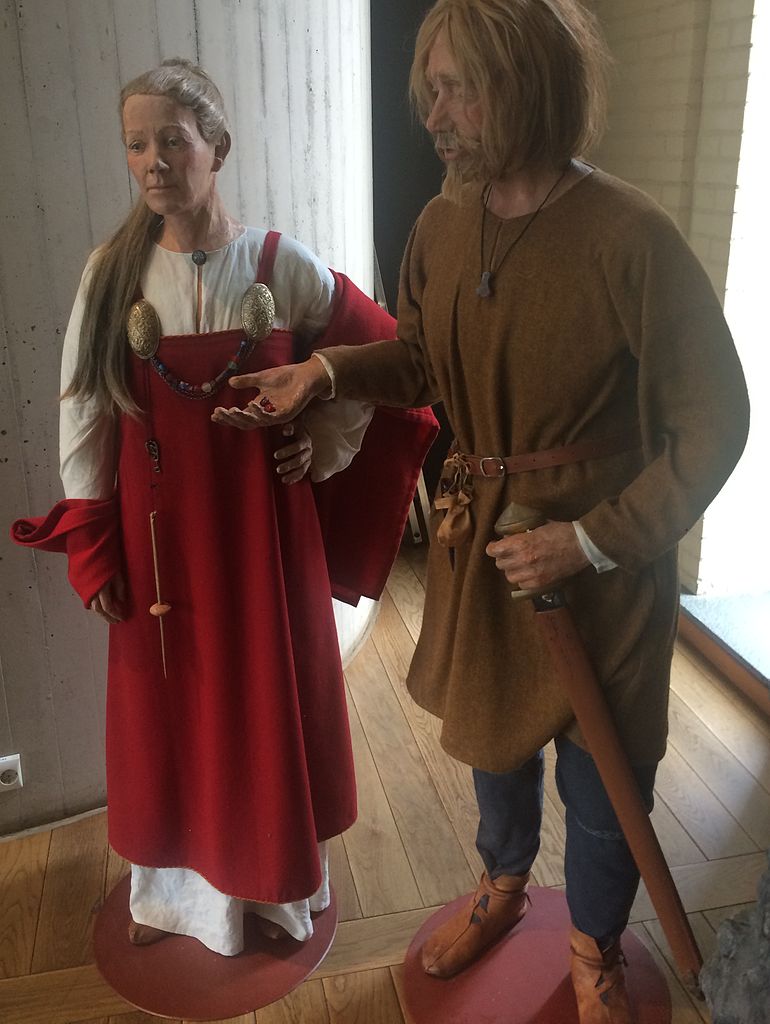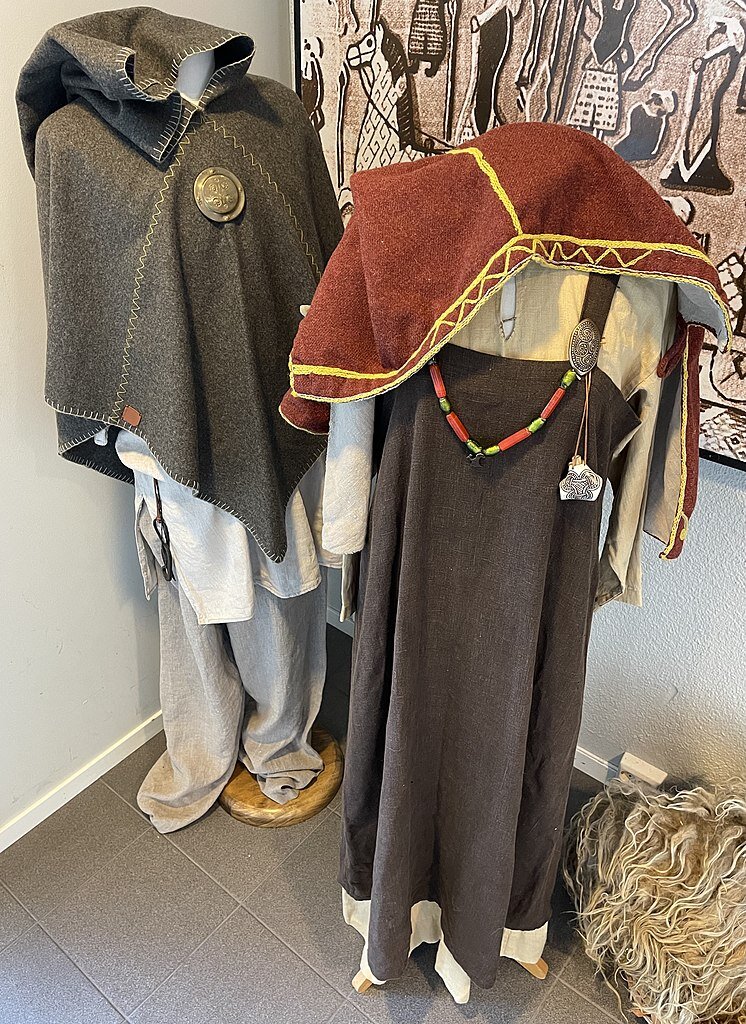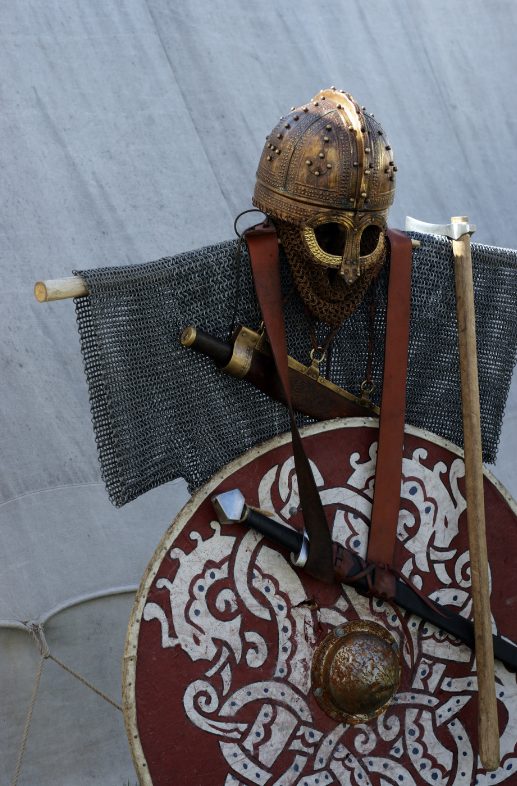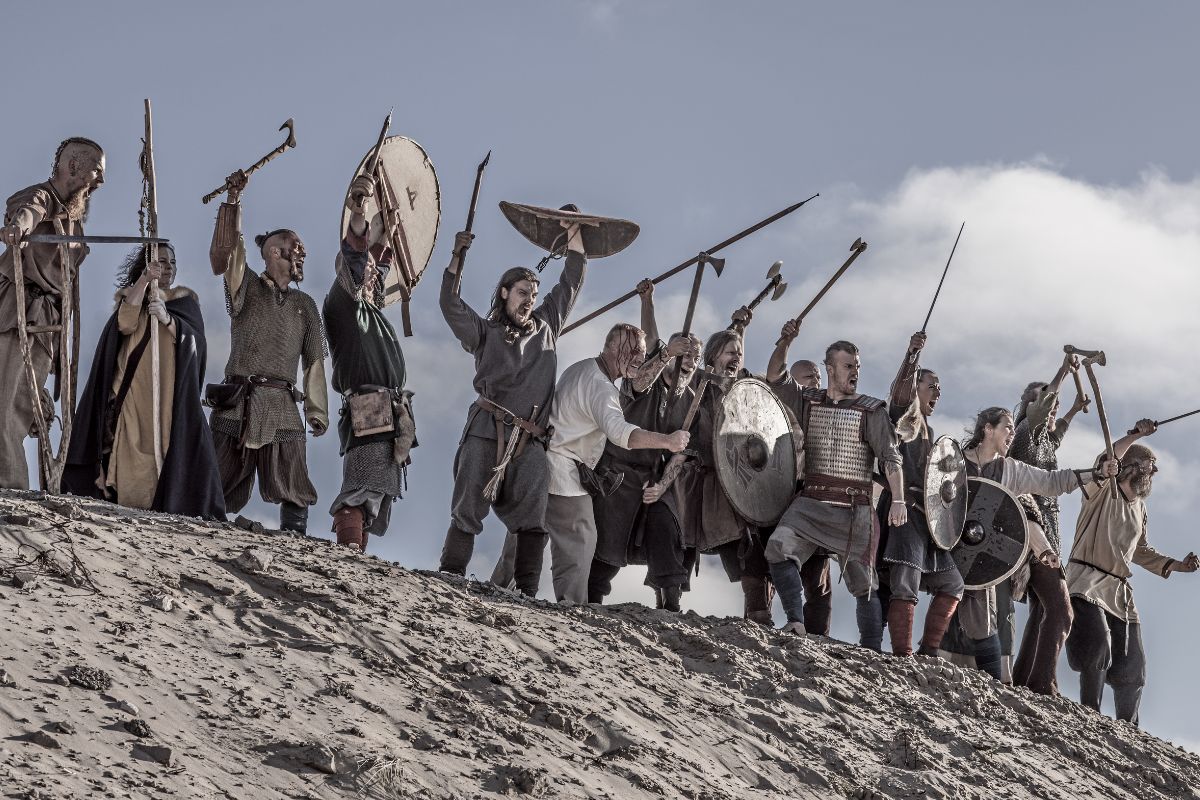We all think of Vikings as warlike people, but most of their time was spent working the land and building and repairing homes, ships, and farming implements. Everyday Viking dress reflected that and was practical and hard-wearing rather than elaborate or battle-related.
The Scandinavian climate is harsh. Long cold winters and mild, sometimes rainy summers mean that any clothing has to keep out the cold and damp.
As a result, Old Norse people favored layers of wool, linen, animal skins, and furs to keep themselves warm and dry.
So What Did The Vikings Wear?
Vikings were no different from other societies throughout history regarding fashion and a desire for quality clothing.
Clothing was not merely practical but also a way of showing your social status and appealing to the opposite sex.
Viking Men
Vikings liked to wear their clothing in layers to keep warm. There were regional variations on a common theme, with most Viking men wearing tunics as an outer garment. These tunics had long sleeves, short sleeves, or were sleeveless for use in warmer weather.
They were quite long, loose-fitting, and reached down to the knees. Viking tunics didn’t have buttons and were pulled on over the head. Men wore trousers of linen or woolen yarn.
Many Viking belt buckles have been found in excavations, so we know these trousers were held up with a leather belt if the person could afford them. Poorer people or slaves would use a simple drawstring to keep their pants up.
Trousers would vary from tight to baggy and decorative to plain. Thinner tunics and trousers also served as underwear.
On the outside of their trouser bottoms, they wore woolen leg wraps from the foot up to the knee. These were worn across Scandinavia but were not typical in Iceland.
Viking Women
Women’s clothing consisted of a shawl often worn over an ankle-length linen underdress with a slightly shorter apron dress of a heavier material worn over it. An iron or bronze “tortoise” broach on either side attached the straps to the dress.
As with the men’s outfits, there were no pockets – Vikings preferred to carry their items in a bag or pouch tied to a narrow belt.
Viking women might also have used brassieres. Circular pieces of metal and remains of cloth containing metal fasteners have been found in a former Viking settlement at Birka near Stockholm, Sweden.
Archaeologist Annika Larsson of Uppsala University says these garments gave “lift and shape to the breast but were banned with the arrival of Christianity, which regarded their wearing as a pagan ritual.”
Danish women of the Viking age preferred plain undergarments, while Swedish ones wore them with pleats.
Viking Children
Children wore smaller versions of what their parents wore. Younger girls wore smocks, while boys wore tunics and trousers.
Chapter 11 of the Fljótsdæla Saga describes the clothes worn by the 10-year-old Grímr and the 12-year-old Helgi. They wore cloaks over striped woolen tunics and trousers.

Clothing Materials and Accessories
Socks And Waterproofing
Vikings used the technique of “needle binding” and not knitting to make their socks. This method was more complicated but made them much more resilient. Poorer people would have to use hay or moss to insulate and protect their feet while wearing shoes or boots.
Needle binding was also used to make hoods, caps, scarves, and mittens, although these were also manufactured from animal skin, such as rabbit or sheep.
Exterior clothing was often made of animal skin and treated with fish oil or beeswax to make it waterproof.
Cloaks And Brooches
Vikings would wear cloaks in harsher weather or to conceal weapons. The more brightly colored and finely crafted ones would be reserved for the wealthier members and jarls (chiefs) of the Norse settlement. Silk clothing was also available to the Vikings, but it had to be imported from the Middle East and was very expensive.
Brooches were used to fasten cloaks and could be made of base or more precious metals. They had several designs ranging from disc to penannular. Women used iron or bronze “tortoise” broaches to attach shoulder straps to their dresses.

Viking Footwear
Their footwear was made of leather but did not last that long. Most Vikings worked on the land and needed practical and comfortable shoes.
Viking footwear tended to be stitched on the inside rather than the outside as they are today. Boots were generally only ankle-length; merchants and the wealthy sometimes wore ones with heels.
Jewelry
Viking women commonly wore necklaces of amber beads as jewelry and hung practical items around their necks, such as scissors or whetstones.
Jewelry was extremely popular in Viking culture, and they were experts at making it. Some excavated Viking settlements have produced stunning examples of iron, bronze, silver, and gold brooches, belt buckles, rings (not just for fingers; arm rings were also popular), pendants, and necklaces.
Viking jewelry was used for decorative and religious purposes.

Clothing Colors & Patterns
Vikings commonly used dyeing techniques to color their clothing. The most popular color for Viking apparel was red, obtained from the plant called “madder.”
Madder did not grow in Scandinavia, and the Vikings had to trade for it in Frankia or Saxony or from traveling sellers. Its scarcity meant it was costly and red clothing was an important status symbol in Nordic culture.
Other colors like black, yellow, blue, purple, and white were more readily available.
Patterns And Symbols
We can see from preserved fabric and some old Norse art on runes and other stones that the Vikings liked patterns and symbols on their clothing, ribbons, and other adornments.

What Did Viking Royalty Wear?
Clothing worn by Viking royalty would have been more elaborate and used higher quality textiles than the lower peasant and slave classes.
Decorative leather and silk were popular choices for wealthier Viking society. Brooches, belt buckles, and other metal clothing accessories would be made of gold or silver instead of bronze or iron. Ceremonial weapons containing jeweled inserts and intricate inlay would also be worn.
Most garments would feature some lacing, pattern, and intricate design, such as Thor’s hammers.
As we have seen, red was seen as a color of social status because the dye needed was expensive and only obtainable from traveling merchants or journeying to lands where it was more readily available.
Viking Warrior Clothing
Viking soldiers would wear their cloaks gathered at one side, leaving their sword hand free and the hilt uncovered.
The Arab diplomat Ibrahim Ahmad ibn Fadlan reported meeting a group of Rus Vikings in the Volga region of Russia.
“I have seen the Rus as they came on their journeys encamped by the Volga. I have never seen more perfect physical specimens, tall as date palms, blond, and ruddy. They wear neither tunics nor kaftans, but the men wear a garment that covers one side of the body, leaving a hand free.”
Vikings wore not heavy armor but fairly rudimentary chain mail or “lamellar” style protection consisting of sewn bronze or leather plates.

Most Viking warriors liked to fight unencumbered and relied on several layers of hemp, linen, or animal skins to protect them.
Agility, evasive tactics, and the effective use of a shield were probably a Viking’s best way of avoiding injury.

How Do We Know Anything About Viking Historial Clothing?
Unfortunately, clothing does not last. Archaeological discoveries are usually limited to small scraps of cloth, like wool or linen, so any idea of the patterns, outfits, and styles is difficult to ascertain.
We have to use texts, excavated artifacts, and preserved runes to understand better how this clothing looked. The findings at Uppsala in Sweden, Oseberg in Norway, and Hedeby in Denmark are fine examples of ancient clothing accessories.
The world-famous Bayeux tapestry is the finest example of Anglo-Saxon wall art from medieval times. It is an embroidered piece of cloth over 200 feet long and about 2 feet high, depicting the events of the Norman Conquest of England in 1066. Some of its depictions show how the Vikings might have dressed.
Many metal items have been uncovered, including belt buckles, brooches, and other items of jewelry. From the number of combs, ear cleaners, and tweezers excavated, we know that grooming and good personal hygiene were prevalent in Viking culture.
Viking Clothing Shown in Historical Reenactments
Many examples of Viking clothing have been brought to life by reenactments or at historical heritage centers.
Recently, live-action role-playing (Larp) has become very popular. The website Andracor.com describes it thus: “A player creates a character according to certain rules, depending on the kind of ‘Larp’ one is attending. This ‘role’ is then portrayed using a previously considered concept and costume.”
*Also, Make sure to check my articles on:

